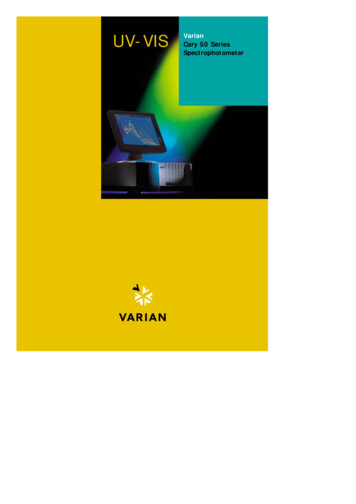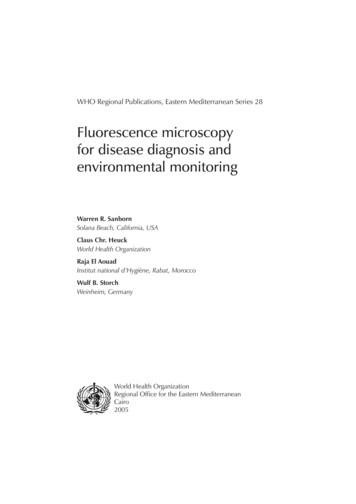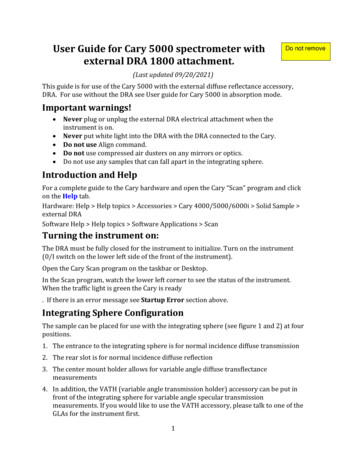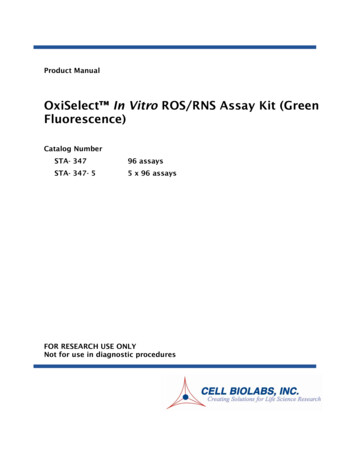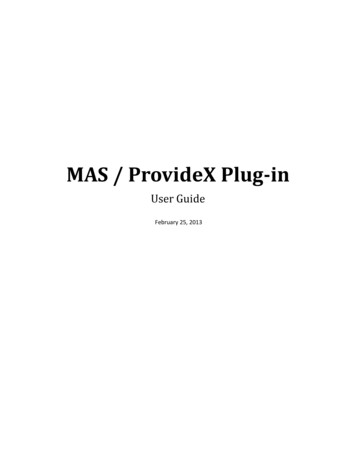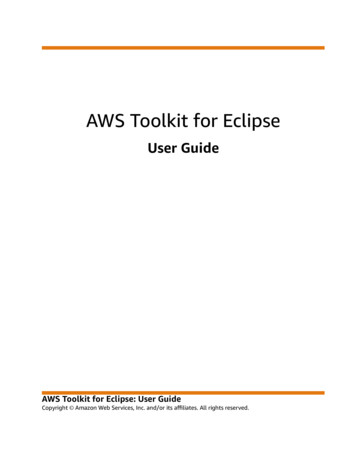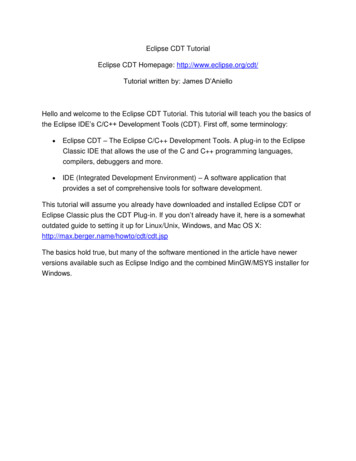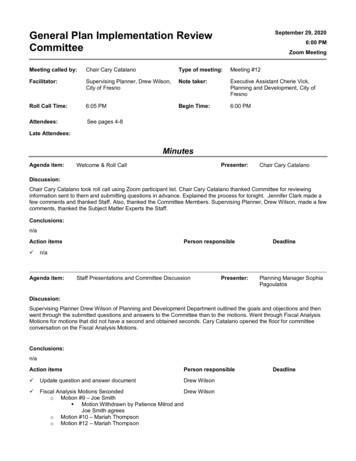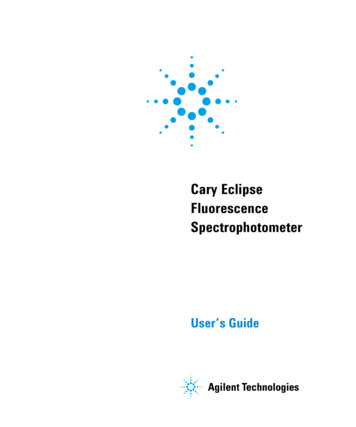
Transcription
Cary EclipseFluorescenceSpectrophotometerUser’s Guide
Notices Agilent Technologies, Inc. 1999,2000 and 2011-2012No part of this manual may bereproduced in any form or by anymeans (including electronic storageand retrieval or translation into aforeign language) without prioragreement and written consent fromAgilent Technologies, Inc. as governedby United States and internationalcopyright laws.Manual Part Number8510175800EditionFourth edition, January 2012Printed in MalaysiaAgilent Technologies, Inc.WarrantyThe material contained in thisdocument is provided “as is,” and issubject to being changed, withoutnotice, in future editions. Further, tothe maximum extent permitted byapplicable law, Agilent disclaims allwarranties, either express or implied,with regard to this manual and anyinformation contained herein,including but not limited to theimplied warranties of merchantabilityand fitness for a particular purpose.Agilent shall not be liable for errorsor for incidental or consequentialdamages in connection with thefurnishing, use, or performance ofthis document or of any informationcontained herein. Should Agilent andthe user have a separate writtenagreement with warranty termscovering the material in thisdocument that conflict with theseterms, the warranty terms in theseparate agreement shall control.Technology LicensesThe hardware and/or softwaredescribed in this document arefurnished under a license and may beused or copied only in accordancewith the terms of such license.Restricted Rights LegendIf software is for use in theperformance of a U.S. Governmentprime contract or subcontract,Software is delivered and licensed as“Commercial computer software” asdefined in DFAR 252.227-7014 (June1995), or as a “commercial item” asdefined in FAR 2.101(a) or as“Restricted computer software” asdefined in FAR 52.227-19 (June 1987)or any equivalent agency regulation or2contract clause. Use, duplication ordisclosure of Software is subject toAgilent Technologies’ standardcommercial license terms, and nonDOD Departments and Agencies of theU.S. Government will receive nogreater than Restricted Rights asdefined in FAR 52.227-19(c)(1-2) (June1987). U.S. Government users willreceive no greater than Limited Rightsas defined in FAR 52.227-14 (June1987) or DFAR 252.227-7015 (b)(2)(November 1995), as applicable in anytechnical data.Safety NoticesCAUTIONA CAUTION notice denotes a hazard.It calls attention to an operatingprocedure, practice, or the like that, ifnot correctly performed or adhered to,could result in damage to the productor loss of important data. Do notproceed beyond a CAUTION noticeuntil the indicated conditions are fullyunderstood and met.WARNINGA WARNING notice denotes ahazard. It calls attention to anoperating procedure, practice, or thelike that, if not correctly performed oradhered to, could result in personalinjury or death. Do not proceedbeyond a WARNING notice until theindicated conditions are fullyunderstood and met.Cary Eclipse Fluorescence Spectrophotometer User’s Guide
ContentsContents1. Safety Practices and Hazards7Lamp module7Ultraviolet radiation8Electrical hazards8Panels, covers and modules9Other precautions9Warning and caution messages10Information symbols11Color coding13CE compliance13Electromagnetic compatibility14EN55011/CISPR11ICES/NMB-0012. Introduction141517Installation ionsEnvironmentalWeights and dimensionsPowerConnectionsCary Eclipse Fluorescence Spectrophotometer User’s Guide1818181919193
ContentsFusesNitrogen supply3. Installation21Single cell holder22Aligning24Other sample holders25Purging25NitrogenPressure regulator and gaugeSupply tubingGas manifoldFlowmeter420202525262626Installing the software26Installing the USB-GPIB-HS Converter28Registering the Cary Eclipse software28Uninstalling the software29Software Status Bulletin29Cary Eclipse Fluorescence Spectrophotometer User’s Guide
Contents4. Maintenance and Spare Parts31Cleaning32Lamp ingSpare Parts5. Troubleshooting38393941Instrument offline41Connect button instead of Start42Instrument performance testing42Cary Eclipse Fluorescence Spectrophotometer User’s Guide5
ContentsThis page is intentionally left blank.6Cary Eclipse Fluorescence Spectrophotometer User’s Guide
Safety Practices and Hazards1. Safety Practices and HazardsLamp moduleUltraviolet radiationElectrical hazardsPanels, covers and modulesOther precautionsWarning and caution messagesInformation symbolsColor codingCE complianceElectromagnetic compatibility788991011131314Your Agilent Cary Eclipse instrument and accessories have beencarefully designed so that when used properly you have an accurate,fast, flexible and safe analytical system.If the equipment is used in a manner not specified by themanufacturer, the protection provided by the equipment may beimpaired.Information on safety practices appears throughout thedocumentation (both hard copy and online) provided with yourinstrument and accessories. Before using the instrument oraccessories, you must thoroughly read these safety practices.Observe all relevant safety practices at all times.Lamp moduleThe lamp is enclosed in a self-contained module. This modulecontains components operating at high voltages. To avoid electricshock, NEVER disassemble the module.Cary Eclipse Fluorescence Spectrophotometer User’s Guide7
Safety Practices and HazardsWhen operating, the lamp module emits high intensity visible andultraviolet (UV) radiation that can cause serious damage to eyes. Toavoid eye damage, never operate the lamp outside the instrument.Ultraviolet radiationHazardous ultraviolet (UV) radiation is emitted by the xenon flashlamp in the instrument. This radiation can cause serious damage toeyes. Never look directly at the UV source lamp. Always wear safetyglasses manufactured to an approved standard and which arecertified or otherwise warranted to protect the eyes from UVradiation when the lamp is operating and the sample compartment isopen.Electrical hazardsThe Cary Eclipse system and some accessories contain electricalcircuits, devices, and components operating at dangerous voltages.Contact with these circuits, devices and components can cause death,serious injury, or painful electrical shock.Panels or covers which are retained by screws on thespectrophotometer and accessories and carry a warning may beopened ONLY by Agilent-trained, Agilent-qualified, or Agilentapproved customer service representatives. Consult the manuals orproduct labels supplied with your computer, monitor and printer todetermine which parts are operator-accessible.Good grounding is essential to avoid a potentially serious electricshock hazard. Ensure that there is an integral ground connectionbetween the metal base of the spectrophotometer and accessoriesand the three pin earth-grounded receptacle. Consult the manuals orproduct labels supplied with your computer, monitor and printer fortheir grounding requirements.NOTE8The safety classification is given as Equipment Class I.Cary Eclipse Fluorescence Spectrophotometer User’s Guide
Safety Practices and HazardsApplication of the wrong supply voltage can create a fire hazard anda potentially serious shock hazard, and could seriously damage theCary Eclipse system, accessories and any attached ancillaryequipment.Do not connect the Cary Eclipse, your computer, monitor, printer oraccessories to the mains power supply until you have made sure thatthey are correctly set for the mains power supply in the specificoutlet in your laboratory to which the equipment will be connected.Consult the manuals supplied with your computer, monitor andprinter for their specific voltage requirements.Replace blown fuses with fuses of the size and rating as stipulated inthe text adjacent to the fuse holder or in the manuals where listed.Replace or repair faulty or frayed insulation on power cords.Panels, covers and modulesYou are permitted to remove the top colored cover toReplace the lamp module.Adjust the lamp module.Any other panels or covers, which are retained by screws on thespectrophotometer and accessories, may be opened ONLY by Agilenttrained, Agilent-qualified, or Agilent-approved service engineers.Consult the manuals or product labels supplied with your computer,monitor and printer to determine which parts are operatoraccessible.Operators and other unauthorized personnel are permitted accessONLY to the lamp module and the sample compartment of the CaryEclipse. ALWAYS switch off the instrument and disconnect the mainscord before changing a lamp module.Other precautionsThe lamp module operates at a high temperature, and touching itmay result in burns. Before replacing a lamp module that has beenoperating, switch off the Cary Eclipse and ensure that the lampmodule has cooled, or protect your fingers from burns.Cary Eclipse Fluorescence Spectrophotometer User’s Guide9
Safety Practices and HazardsDo not block the ventilation grilles on the spectrophotometer andaccessories. Consult the manuals supplied with your computer,monitor and printer for their specific ventilation requirements.Use of the Cary Eclipse system and accessories may involvematerials, solvents and solutions, which are flammable, corrosive,toxic or otherwise hazardous.Careless, improper, or unskilled use of such materials, solvents andsolutions can create explosion hazards, fire hazards, toxicity andother hazards which can result in death, serious personal injury, anddamage to equipment and property.ALWAYS ensure that laboratory safety practices governing the use,handling and disposal of such materials are strictly observed. Thesesafety practices should include the wearing of appropriate safetyclothing and safety glasses.Warning and caution messagesCarefully read all warnings and cautions and observe them at alltimes.A Warning message is used in the text when failure to observeinstructions or precautions could result in death or injury. Warningshave the following format:WARNINGHazard TypeNature of the hazard, information on how to avoid the hazard, and possibleconsequences if you don’t.The triangular symbols that appear in conjunction with warnings areoutlined in the next section.A Caution message is used when failure to observe instructions couldresult in damage to equipment (Agilent-supplied and/or otherassociated equipment).10Cary Eclipse Fluorescence Spectrophotometer User’s Guide
Safety Practices and HazardsCautions have the following format:CAUTIONCaution information appears here.Information symbolsThe following triangular symbols appear in conjunction withwarnings on the spectrometer and associated documentation. Thehazard they depict is shown below each symbol:Corrosive liquidEjecting partsElectrical shockExtreme coldEye hazardFire hazardHeavy weight(danger to feet)Heavy weight(danger to hands)Hot surfaceMoving partsNoxious gasSharp edgeCary Eclipse Fluorescence Spectrophotometer User’s Guide11
Safety Practices and HazardsThe following symbol may be used on warning labels attached to theinstrument. When you see this symbol, refer to the relevant operationor service manual for the correct procedure referred to by thatwarning label.The following symbols also appear on the instrument or in thedocumentation:IMains power on.0Mains power off.Single phase alternating current.Direct current.Fuse.Indicates that a high voltage xenon flash lamp is present.XeFocus. Horizontal movement.Vertical movement.When attached to the rear of the instrument, indicates that theproduct complies with the requirements of one or more EUdirectives.When attached to the rear of the product, indicates that the producthas been certified (evaluated) to CSA 61010.1 and UL 61010-1.12Cary Eclipse Fluorescence Spectrophotometer User’s Guide
Safety Practices and HazardsColor codingThe various indicator lights appearing on Agilent instruments andassociated accessories are color-coded to represent the status of theinstrument or accessory.A steady green light indicates the instrument is in normal orstandby mode.A flashing green light indicates the instrument isscanning/reading.A steady orange light indicates the instrument is starting up.A flashing orange light indicates that there is a problem with theinstrument, and it may require servicing.A steady yellow light indicates that the instrument is initializing.CE complianceAgilent Cary Eclipse instruments have been designed to comply withthe requirements of the Electromagnetic Compatibility (EMC)Directive and the Low Voltage (electrical safety) Directive (commonlyreferred to as the LVD) of the European Union. Agilent hasconfirmed that each product complies with the relevant directives bytesting a prototype against the prescribed EN (European Norm)standards.Proof that a product complies with the directives is indicated by:The CE marking appearing on the rear of the product.The documentation package that accompanies the product,containing a copy of the Declaration of Conformity. Thisdeclaration is the legal declaration by Agilent that the productcomplies with the directives and also shows the EN standards towhich the product was tested to demonstrate compliance.Cary Eclipse Fluorescence Spectrophotometer User’s Guide13
Safety Practices and HazardsElectromagnetic compatibilityEN55011/CISPR11Group 1 ISM equipment: group 1 contains all ISM equipment inwhich there is intentionally generated and/or used conductivelycoupled radio- frequency energy which is necessary for the internalfunctioning of the equipment itself.Class A equipment is equipment suitable for use in allestablishments other than domestic and those directly connected to alow voltage power supply network which supplies buildings used fordomestic purposes.This device complies with the requirements of CISPR11, Group 1,Class A as radiation professional equipment. Therefore, there may bepotential difficulties in ensuring electromagnetic compatibility inother environments, due to conducted as well as radiateddisturbances.Operation is subject to the following two conditions:1This device may not cause harmful interference.2This device must accept any interference received, includinginterference that may cause undesired operation.If this equipment does cause harmful interference to radio ortelevision reception, which can be determined by turning theequipment off and on, the user is encouraged to try one or more ofthe following measures:141Relocate the radio or antenna.2Move the device away from the radio or television.3Plug the device into a different electrical outlet, so that the deviceand the radio or television are on separate electrical circuits.4Make sure that all peripheral devices are also certified.5Make sure that appropriate cables are used to connect the deviceto peripheral equipment.Cary Eclipse Fluorescence Spectrophotometer User’s Guide
Safety Practices and Hazards6Consult your equipment dealer, Agilent Technologies, or anexperienced technician for assistance.7Changes or modifications not expressly approved by AgilentTechnologies could void the user’s authority to operate theequipment.ICES/NMB-001This ISM device complies with Canadian ICES- 001.Cet appareil ISM est conforme à la norme NMB-001 du Canada.Cary Eclipse Fluorescence Spectrophotometer User’s Guide15
Safety Practices and HazardsThis page is intentionally left blank.16Cary Eclipse Fluorescence Spectrophotometer User’s Guide
Introduction2. IntroductionInstallation llation requirementsBefore receiving your instrument, you will have been provided with aCary Eclipse Site Preparation Guide, which describes theenvironmental and operating requirements of the Agilent CaryEclipse system. You must prepare your laboratory according to theseinstructions before the Cary Eclipse can be installed. You shouldkeep the site preparation guide for future reference. If you havemisplaced your copy, you can obtain a replacement from your localAgilent office or from the Agilent website, www.agilent.comDocumentationYou have been provided with the following documentation to helpyou set up and operate your Cary Eclipse system:This user’s guide, with safety practices and hazards information,instructions for installing and maintaining the components of theCary Eclipse and software, and troubleshooting informationExtensive Help (provided with the Cary Eclipse software)containing context-sensitive Help, step-by-step instructions forfrequently performed analyses and instructions for using anyaccessories you ordered.Cary Eclipse Fluorescence Spectrophotometer User’s Guide17
IntroductionConventionsThe following conventions have been used in procedures throughoutthe documentation:Menus, menu items, buttons and check boxes have been typed inbold. (for example, ‘click OK’ and ‘From the Edit menu, chooseCopy’.ALL CAPITALS indicate keyboard commands. For example,‘press ENTER’ and ‘press SHIFT F8’.SpecificationsThe instrument is suitable for indoor use only and is classifiedPollution degree 2 and Installation Category II (EN 61010-1).EnvironmentalTable 1. Suitable conditions during instrument transportation, non-operation and operationConditionAltitude (m, ft)Temperature( C, F)Relative humidity,non-condensing (%)Non-operating (transport)0–2133, 0–70005–45, 41–11320–80Operating within performancespecifications0–853, 0–2800853–2133, 2800–700010–35, 50–9510–25, 50–778–80For optimum analytical performance, it is recommended that theambient temperature of the work area be between 20 and 25 C (68and 77 F) and be held constant to within 2 C throughout theentire working day.18Cary Eclipse Fluorescence Spectrophotometer User’s Guide
IntroductionWeights and dimensionsWeightPacked: 54 kg (119 lb)Unpacked: 31 kg (68 lb)Dimensions (width x depth x height)Packed: 820 x 760 x 560 mm (32 x 30 x 22 in)Unpacked: 600 x 610 x 280 mm (24 x 24 x 11 in)PowerVoltage: 100–240 VAC 10%Frequency: 50 to 60 Hz 1 HzConsumption: 180 VA (approximately)Mains inlet coupler: 3/2 A 120/250 VAC 50–60 Hz IEC typeConnectionsMains power cordOnly use the country specific, Agilent supplied power cord with yourCary Eclipse.FrontAccessory connection: 25-pin D-range connector (low voltage DC/ACand digital/analog lines)RearIEEE 488 (GPIB Cary Eclipse system connection)Cary Eclipse Fluorescence Spectrophotometer User’s Guide19
IntroductionSample compartment9-pin D-range connector (low voltage AC/DC)15-pin D-range connector (low voltage AC/DC)25-pin D-range connector (low voltage AC/DC)FusesT3.15 AH 250 V (5 x 20 mm) IEC127 Sheet 5NOTEFor safety reasons, any other internal fuse or circuit breaker is not operatoraccessible, and should be replaced only by Agilent-authorized personnel.Fuse information on the rear of the instrument is the most up-todate.Nitrogen supply70 kPa (10 psi)20Cary Eclipse Fluorescence Spectrophotometer User’s Guide
Installation3. InstallationSingle cell holderOther sample holdersPurgingInstalling the softwareInstalling the USB-GPIB-HS ConverterRegistering the Cary Eclipse softwareUninstalling the softwareSoftware Status Bulletin2225252628282929The Agilent Cary Eclipse must be installed only by an Agilent-trainedor Agilent-authorized representative.WARNINGHeavy Weight HazardThe Cary Eclipse weighs over 30 kg (66 lb). To avoid injury to personnel ordamage to equipment, always use two or more people when lifting orcarrying the instrument. Never attempt to lift the instrument alone.Following the instructions, in the site preparation guide, you shouldhave:Unpacked the fluorescence spectrophotometer and placed it onthe workbench.Unpacked the computer and placed it on the workbench.Installed the operating system software on the computer.Cary Eclipse Fluorescence Spectrophotometer User’s Guide21
InstallationThis chapter describes how to install the:Sample holders used with the Cary Eclipse.Cary Eclipse software, in case you ever need to reinstall it.Instructions for installing/replacing the lamp module are included inthe ‘Maintenance’ chapter.Single cell holderA single cell holder is supplied as standard with the Cary Eclipse.Follow these instructions to install and align it.To install the single cell holder:1Slide back the sample compartment lid (‘1’ in Figure 1), lift upand remove the front panel (2) and check that the samplecompartment is empty.123Figure 1. Cary Eclipse showing the sample compartment lid (1) and front panel(2) and Lamp Access Panel (3)222Position the cell holder base on the locating pins.Cary Eclipse Fluorescence Spectrophotometer User’s Guide
Installation3Lock the cell base by turning the lever (‘2’ in Figure 2) to theright.Figure 2. Cell holder base (left) and Single cell holder1) Locating holes2) Cell holder locking lever3) Cell lifter and height adjuster4) Cell holder thumbscrew5) Pitch adjustment screw4Place the single cell holder on the cell holder base so that the celllifter (3) is at the rear of the sample compartment.5Secure the cell holder by tightening the spring-loadedthumbscrew (4).Cuvette height adjustmentTurning the cell lifter (3) in a clockwise direction will raise thecuvette.Turning the cell lifter (3) in an counter-clockwise direction willlower the cuvette platform.NOTETo lower the cuvette you will have to push the cuvette down because of thetension created by the single cell holder.Cary Eclipse Fluorescence Spectrophotometer User’s Guide23
InstallationCuvette pitch adjustmentNOTE1Turning the pitch adjustment screw (5) in a clockwise directionwill raise the front of the cell holder.2Turning the pitch adjustment screw (5) in an anti-clockwisedirection will lower the front of the cell holder.The pitch adjustment screw requires a 2.5 mm hex key.AligningTo align the single cell holder (containing a microcell):NOTE241Start the Align application by clicking the Start button in theWindows taskbar and choosing All Programs Agilent CaryEclipse Align.2Click the Cary tab.3Place a fluorescent sample (for example, anthracene) in amicrocell and adjust the excitation and emission wavelengths toget a signal.4Click Apply. (The wavelengths should change and the greenpower indicator on the instrument should continue flashing toindicate that the instrument is active.)5Place a small piece of white paper in the light path to the right ofthe cell (use a wavelength of 540 nm). If the beam appears asthough it will strike the cell aperture, move the paper to the leftof the cell and check that the beam is passing through the cell. (Ifthe beam does not appear as though it will pass through the cell,adjust the height of the cell as described on Page 23).6Using the 2.5 millimeter hexagonal ball driver, adjust the pitchadjustment screw (‘5’ in Figure 2) and note the intensity of thelight striking the paper. Continue to adjust the adjustment screwuntil the beam hitting the paper appears the most intense.You may need to dim the room lights to see the light beam.Cary Eclipse Fluorescence Spectrophotometer User’s Guide
InstallationOther sample holdersOther sample holders are available for use with the Cary Eclipse.Instructions for their use are included in the Help provided with theCary Eclipse software.PurgingThe nitrogen purging system is not supplied by Agilent, but thefollowing items are available from appropriate commercial suppliers.NitrogenLiquid nitrogen (in conjunction with a heat exchanger) isrecommended because it is less expensive than compressed nitrogenand is usually of better quality. If compressed nitrogen must be used,the gas must be dry, oil-free and uncontaminated.CAUTIONNOTENever use compressed nitrogen from a supplier who uses oil or water in thecompression process. Such processes invariably leave fine particles of oilsuspended in the nitrogen, which will form an oily deposit on optical surfaces.Use nitrogen from a supplier who fills containers from immersion pumpslubricated with liquid nitrogen.The instrument warranty will be void if damage is caused by the use ofunsatisfactory nitrogen.Pressure regulator and gaugeOperating pressure is from 70 kPa (10 psi). Always use anappropriate regulator and gauge to ensure that the nitrogen supply isconsistently maintained at the correct pressure.Cary Eclipse Fluorescence Spectrophotometer User’s Guide25
InstallationSupply tubingUse clean, flexible plastic (Tygon polyvinyl chloride (PVC) orequivalent) tubing of 6 millimeter (1/4 inch) internal diameter. Neveruse rubber tubing because it may be treated internally with talc,which can be blown into the optical system.CAUTIONNever use rubber tubing, because it may be treated internally with talc, whichcan be blown into the optical system.Gas manifoldA gas manifold should be fitted with an inlet suitable for connectionto the nitrogen supply system and an outlet suitable for connection tothe spectrophotometer.FlowmeterA flowmeter (complete with control valves) should be inserted in thesystem between the nitrogen supply system and thespectrophotometer. The flowmeter should be capable of monitoringflow rates between 0 and 30 liters per minute (64 cubic feet perhour).Installing the softwareTo install the Cary Eclipse WinFLR software:1Log on to the instrument computer with Administratorprivileges.2Insert the software disk, and click OK.If using Windows 7 operating system, a User Account Controldialog box will appear, click Yes for ‘Do you want to allowthe following program to make changes to this computer?’.NOTE26If no installation screen appears, run ‘EclipseSetup.exe’ from the CD directory.Cary Eclipse Fluorescence Spectrophotometer User’s Guide
Installation3NOTENOTEFollow the prompts on the screen until the ‘Select DestinationLocation’ window appears. Confirm the directory in which youwould like to install the application. Alternatively, click Browseto choose a different location. Click Next.Agilent strongly recommends that the Agilent\Cary Eclipse WinFLR folder andapplications be installed in the recommended directory.4The ‘Folder Does Not Exist’ dialog box may appear. Click Yes tocreate the folder.5Follow the prompts on the screen until the ‘Ready to Install’window appears. Click Install.During the installation of the .Net Framework and GPIB driver, the computer mayappear frozen and the ‘Cancel’ button is unavailable. This is correct. Theinstallation can take 3 to 5 minutes. Do not try to exit the installation during thistime.6If prompted to complete installation of Cary WinFLR byrestarting your computer, select No, I will restart the computerlater. Click Finish.7Remove the Cary Eclipse Software disk from the CD drive andinsert the Cary Eclipse Help disk, as prompted.If using Windows 7 operating system, a User Account Controldialog box will appear, click Yes for ‘Do you want to allowthe following program to make changes to this computer?’.NOTEIf no installation screen appears, run ‘CaryFlrHelp\setup.exe’ from the CD directory.8Follow the instructions on the screen to install the Help.9When the status indicates ‘Finished’, click Close.10 Remove the Help disk from the CD drive.Cary Eclipse Fluorescence Spectrophotometer User’s Guide27
InstallationInstalling the USB-GPIB-HS ConverterTo install a National Instruments USB-GPIB-HS converter:NOTEEnsure that the Cary Eclipse WinFLR software has been installed.1Turn off the computer.2Connect one end of the converter to the instrument and the otherend to the USB connection on the back of the computer.3Turn on the computer.Registering the Cary Eclipse softwareTo register the Cary Eclipse software:NOTE1Click Start All Programs Agilent Cary Eclipse and thenthe desired application. Alternatively, double-click the CaryEclipse folder on the desktop2The first time the Cary Eclipse software is opened a SoftwareRegistration dialog will appear. Click Next.Ensure the software registration is completed by the user of the instrument. Forfurther information refer to the Software Registration Help.3NOTE28Complete all the fields on the ‘Customer Details’ page. ClickNext.The Product Key is found on the cover of the Agilent Cary Eclipse softwareCD/DVD case which was delivered with the instrument.4Complete all the fields on the ‘Product Details’ page. Click Next.5Complete all the fields on the ‘Work Environment Details’ page.Click Register.6A dialog appears stating ‘Your Agilent Software Registration hasbeen successful’.Cary Eclipse Fluorescence Spectrophotometer User’s Guide
InstallationNOTEIf your computer is not connected to the internet, refer to the SoftwareRegistration Help for further information.7TIPThe application will now open, and you can collect your data.To familiarize yourself with the Cary Eclipse WinFLR software, browse the Helpafter installing the software. To access the Help, with a Cary Eclipse applicationopen press F1 on your keyboard or click Start All Programs Agilent CaryEclipse Cary Eclipse Help.Uninstalling the softwareTo uninstall the Cary Eclipse software:NOTE1Click the Windows Start button. Choose Settings, Control Panel,Add/Remove programs.2Scroll until you find ‘Cary Eclipse WinFLR’.3Click Add/Remove and then Yes. Follow the instructions on thescreen.During the uninstallation, you may be prompted to remove certain drivers/files.Click ‘No’ to these prompts, as other programs may rely on these files to run.4Repeat the process for the Cary Eclipse Help.Software Status BulletinBefore proceeding further, you should read the Software StatusBulletin document supplied with the software and the Agilent CaryEclipse WinFLR version 1.2 Release Notes.pdf located in the installdirectory. These documents contain the latest release informationand important notes.Cary Eclipse Fluorescence Spectrophotometer User’s Guide29
InstallationThis page is intentionally left blank.30Cary Eclipse Fluorescence Spectrophotometer User’s Guide
Maintenance and Spare Parts4. Maintenance and Spare PartsCleaningLamp moduleFusesSpare Parts32323839This chapter includes th
Cary Eclipse Fluorescence Spectrophotometer User's Guide 9 Application of the wrong supply voltage can create a fire hazard and a potentially serious shock hazard, and could seriously damage the Cary Eclipse system, accessories and any attached ancillary equipment. Do not connect the Cary Eclipse, your computer, monitor, printer or
